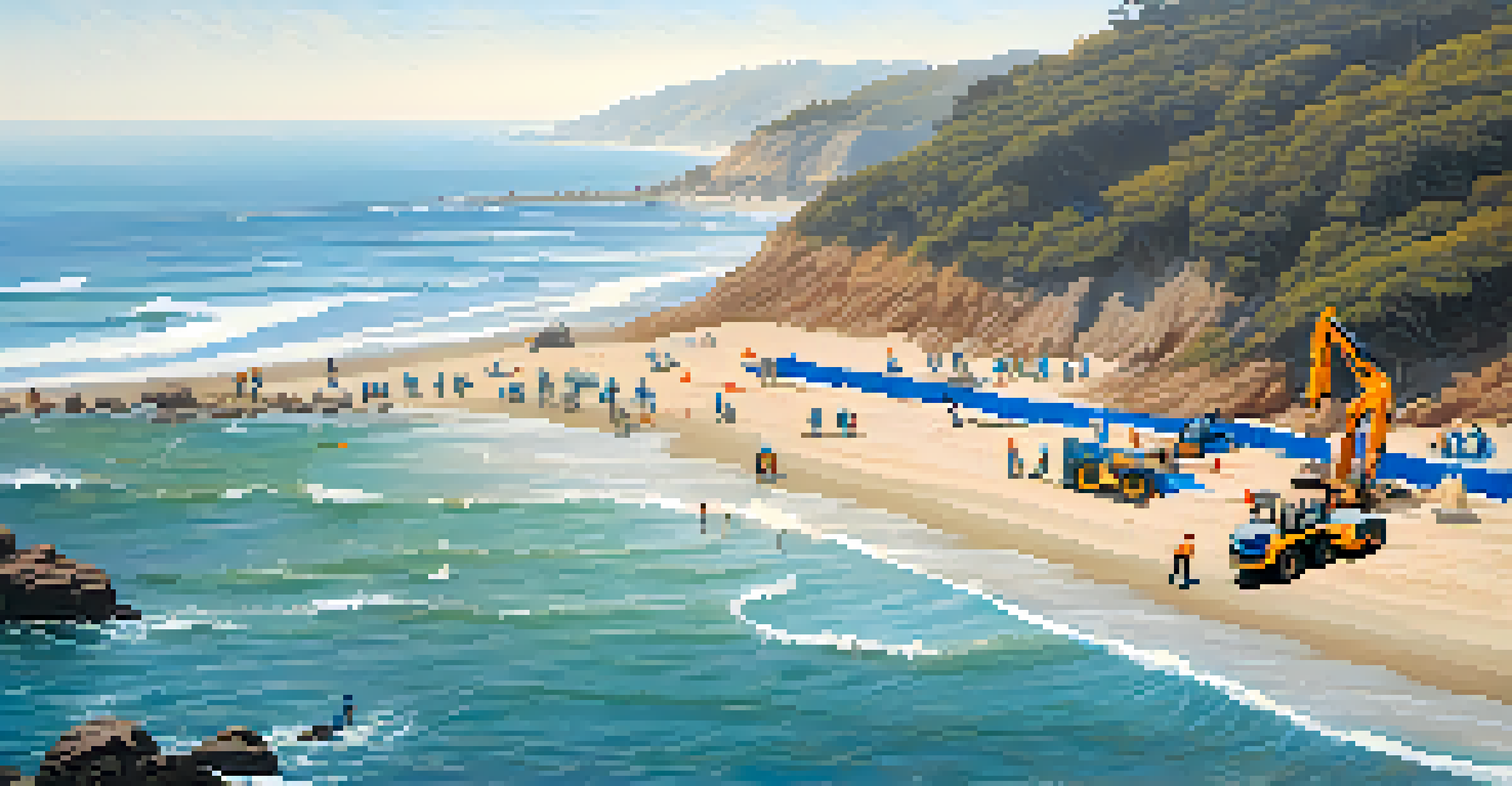Impacts of Coastal Erosion on Malibu's Beaches and Wildlife

Understanding Coastal Erosion in Malibu
Coastal erosion is a natural process where waves, currents, and tides wear away the land. In Malibu, this phenomenon is particularly pronounced due to its beautiful, but vulnerable beaches. Factors such as rising sea levels and intense storms have accelerated erosion, posing significant challenges to the area.
The coast is like a living organism; it ebbs and flows, and so must our understanding of how to protect it.
The dynamic nature of Malibu’s coastline means that it’s not just a matter of losing sand; it affects the entire ecosystem. Over time, homes and businesses built close to the shore face the risk of being undermined. This ongoing battle between land and sea raises important questions about conservation and urban planning.
To combat these changes, local authorities are exploring various strategies, including beach nourishment and the construction of protective barriers. However, these solutions are often temporary, leading to the need for ongoing monitoring and adaptive management of the coastline.
Impact of Erosion on Malibu's Beaches
Malibu's beaches are not only a picturesque retreat but also a key part of its identity. Coastal erosion can lead to significant loss of sandy shorelines, impacting recreational activities and tourism. As the beaches shrink, visitors may find their favorite spots disappearing, which could dissuade them from returning.

Moreover, the reduction in beach area can lead to increased crowding in remaining spaces. This can create a negative experience for beachgoers and disrupt the local businesses that rely on tourism. The economic implications of this erosion are profound, affecting everything from local jobs to city revenue.
Coastal Erosion Threatens Malibu
Malibu's beautiful beaches face significant erosion due to rising sea levels and storms, impacting the ecosystem and local infrastructure.
As beaches retreat, the natural habitats for wildlife are also compromised. The loss of beachfront can disrupt the nesting sites for various species, such as sea turtles and shorebirds, further highlighting the interconnectedness of the ecosystem.
Wildlife at Risk Due to Coastal Changes
Malibu's coastal areas are home to a diverse range of wildlife, including marine mammals, birds, and fish. Erosion impacts these species by disrupting their natural habitats and food sources. For instance, as sand dunes erode, the nesting grounds for seabirds diminish, leading to declines in their populations.
We won't have a society if we destroy the environment.
Additionally, the changing shoreline can affect marine life that relies on estuarine environments. Fish and other aquatic species may struggle to find suitable breeding grounds, which can impact the overall health of marine ecosystems. This ripple effect underscores the importance of protecting these habitats.
Conservation efforts are vital to mitigate these impacts. Local organizations are working hard to promote awareness and implement sustainable practices that can help preserve both the beaches and the wildlife that depend on them.
Economic Consequences of Coastal Erosion
The economic impacts of coastal erosion in Malibu extend beyond just the loss of beach space. With a strong tourism industry reliant on its beautiful coastline, diminished beaches can lead to reduced visitor numbers and lower spending in local businesses. Restaurants, shops, and hotels may all see downturns in revenue.
Moreover, property values along the coast may decline as the threat of erosion becomes more evident. Homeowners may find it difficult to sell their properties, leading to potential financial losses. This creates a ripple effect, impacting the local economy and government tax revenues.
Economic Impact of Beach Loss
The reduction of beach area due to erosion threatens tourism and local businesses, potentially leading to decreased property values and revenue.
In response, some businesses and homeowners are investing in protective measures, such as sea walls or beach replenishment projects. However, these solutions often come with their own costs and challenges, making it essential for the community to carefully weigh their options.
Community Responses to Erosion Challenges
As coastal erosion continues to threaten Malibu, community engagement has become increasingly important. Awareness campaigns and educational programs help residents understand the impacts of erosion and the importance of sustainable practices. The community is coming together to find collective solutions to protect their coastline.
Local government initiatives often involve collaboration with environmental organizations to create long-term strategies. These partnerships can lead to innovative approaches, such as creating living shorelines that boost resilience and enhance habitats. Community input is crucial in shaping these initiatives to ensure they meet local needs.
Moreover, grassroots movements have emerged, pushing for stricter regulations on coastal development and advocating for stronger conservation efforts. This united front demonstrates the community's commitment to preserving Malibu’s unique environment for future generations.
The Role of Policy in Coastal Management
Effective policy is key in addressing the challenges posed by coastal erosion. Local and state governments play a significant role in regulating land use and implementing protective measures. Policies that prioritize environmental sustainability can help mitigate the impacts of erosion while supporting the local economy.
Coastal zone management policies aim to balance development with conservation. This can include zoning laws that restrict building near the shore and promoting the use of natural methods to protect coastlines. By incorporating scientific research and community input, policymakers can create more effective strategies.
Community Action for Coastal Protection
Community engagement and innovative policies are crucial for addressing coastal erosion and protecting Malibu's unique environment for future generations.
However, the challenge lies in ensuring that these policies are adaptable to changing conditions. As climate change continues to accelerate erosion, it’s crucial for policymakers to stay informed and ready to adjust regulations to safeguard Malibu’s beaches and wildlife.
Looking Ahead: Future of Malibu's Coastline
The future of Malibu’s coastline is uncertain, but proactive measures can make a difference. Community awareness and engagement are essential in driving sustainable practices and supporting conservation efforts. By embracing a collective approach, residents can help protect their beaches and the wildlife that inhabit them.
Innovative solutions, such as using technology for monitoring erosion patterns, can provide valuable data for decision-making. This information can guide restoration projects and help identify areas most at risk. Collaboration between scientists, policymakers, and the community will be vital in these efforts.

Ultimately, the preservation of Malibu's coastline relies on a shared commitment to sustainability. By prioritizing the health of both the beaches and the ecosystems they support, Malibu can continue to be a vibrant, thriving community for generations to come.